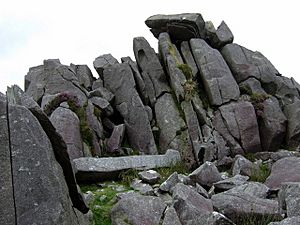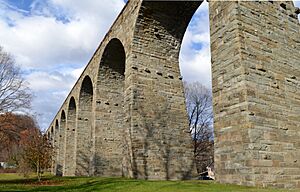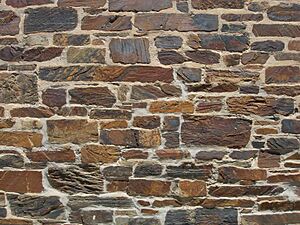Bluestone facts for kids

Bluestone is a common name for several types of natural building stones. People use this name for different rocks that are often blue or grey.
Here are some types of rock called bluestone:
- basalt in Victoria, Australia, and in New Zealand.
- dolerite in Tasmania, Australia, and in Britain (like at Stonehenge).
- feldspathic sandstone in the US and Canada.
- limestone in the Shenandoah Valley in the US, Belgium, and Ireland.
- slate in South Australia.
Bluestone is different from man-made blue brick.
Contents
Bluestone at Stonehenge

At Stonehenge in Britain, "bluestone" is a general name for all the rocks that didn't originally come from the Stonehenge area. It's not a scientific geology term. There are at least 46 different kinds of rock at Stonehenge!
One common bluestone there is called Preseli Spotted Dolerite. This is a dark, heavy rock that is harder than granite. It has spots of different minerals in it.
Tools made from Preseli bluestone, like axes, have been found in other parts of Britain. Many of these tools seem to have been made near Stonehenge.
The bluestones were first used at Stonehenge around 2300 BC. People think there were about 80 large bluestones originally, but only 43 are left today. Each stone weighs between 2 and 4 tons. Most of them are believed to have come from the Preseli Hills in Wales. This area is about 250 kilometers (150 miles) away.
Scientists have two main ideas about how the stones got to Stonehenge:
- A glacier (a huge sheet of ice) carried them.
- Humans moved them.
Did a Glacier Move the Stones?
Some scientists think the Irish Sea Glacier might have carried the bluestones from Wales to Stonehenge. This idea is called the "glacial erratic theory."
In 2015, researchers said they found no strong proof that people quarried (dug up) the stones at Rhosyfelin in the Preseli Hills. If a glacier moved the stones, you might expect to find other bluestone boulders near Stonehenge. However, no other large bluestones have been found there, only small pieces.
Did Humans Move the Stones?
Other scientists believe that humans moved the bluestones. The discovery of the Boscombe Bowmen (ancient people buried near Stonehenge) supports this idea. Also, bluestone axe heads have been found around the Preseli Hills. This shows that people in that area knew how to work with these stones.
In 2015, some researchers claimed that certain stones at Stonehenge came from ancient quarries at Carn Goedog and Craig Rhos-y-felin in the Preseli Hills. However, other experts strongly disagree. They say that the so-called quarry features are natural formations, made by glaciers and ice over a long time. They also say there is no clear proof that people moved these large bluestones all the way from Wales to Stonehenge.
Bluestone in Australia
Australia has three different building materials called "bluestone."
Victoria
In Victoria, bluestone is a type of rock called basalt. It was a very popular building material during the Victorian Gold Rush in the 1850s.
In Melbourne, bluestone was dug up from quarries in areas like Clifton Hill and Coburg. The quarry that provided stone for Pentridge Prison is now Coburg Lake. Bluestone was also used in other towns across Victoria, such as Ballarat and Geelong. It is still quarried in some places today.
Bluestone is a very hard rock, so it was difficult to shape. Because of this, it was often used for warehouses, walls, and building foundations. However, many important buildings are made of bluestone. These include the Old Melbourne Gaol, Pentridge Prison, and St Patrick's Cathedral. Other examples are Princes Bridge and the Hawthorn Bridge.
Bluestone was also widely used for cobblestone streets and footpaths in Melbourne. Crushed bluestone, called "blue metal," is used for railway tracks, roads, and making concrete.
South Australia
In South Australia, "bluestone" refers to a type of slate. It's not as strong as Victorian bluestone, but people liked its pretty look. The inside of the stone is usually light grey or beige. However, its surfaces have attractive colors from minerals like iron oxide.
This slate was popular from the 1850s to the 1920s. It was quarried in the Adelaide Hills in places like Dry Creek and Glen Osmond.
Tasmania
In Tasmania, "bluestone" is the name for dolerite. This rock is very common in Tasmania's landscape and is used for many different building purposes.
Bluestone in New Zealand
Timaru bluestone (also called Port Chalmers bluestone) is a nice building material. It's a grey basalt, similar to Victorian bluestone. It's dug up near Timaru in New Zealand's South Island.
Bluestone from Kokonga in Central Otago is also widely used. It's the main building material for many old buildings in the southern South Island. These buildings were built during the rich period after the Otago gold rush. Often, bluestone is combined with Oamaru stone, a local light-colored limestone. Famous buildings like the Otago University Registry Building and Dunedin Railway Station use this mix.
Bluestone in the United States and Canada

There are two different building materials called "bluestone" in the United States. One of them is also found in Canada.
Bluestone from Pennsylvania and New York is a type of sandstone. This sandstone formed about 370 to 345 million years ago. It came from sand and mud that washed into a large delta called the Catskill Delta. This delta was created by rivers flowing from ancient mountains.
The name "bluestone" came from a deep-blue sandstone first found in Ulster County, New York. However, it can also be grey or brown. Digging for bluestone is very important for the economy of Susquehanna County, Pennsylvania. The Starrucca Viaduct, built in 1848, is a great example of Pennsylvania bluestone used in construction. Bluestone is quarried in western New Jersey, Pennsylvania, eastern New York, and in Newfoundland, Canada.
The other, less known, American "bluestone" is a blue-colored limestone. It is found in the Shenandoah Valley of Virginia. This limestone formed about 450 to 500 million years ago at the bottom of a shallow ocean. It was darker than other limestones because it was in deeper water with less light.
This darker blue color led to it being called "bluestone." The area has one of the world's largest limestone deposits. After being exposed to sun and rain for a long time, the stone fades from deep blue to light grey. Early settlers used this bluestone for house foundations and chimneys. When James Madison University was built, local bluestone was used for its buildings because it was good quality and part of the local history.
See also
- Theories about Stonehenge




